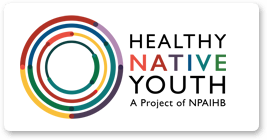Submitting your Curriculum
It can be challenging for health educators to locate engaging, age-appropriate health curricula for Native youth. Our goal is to make Healthy Native Youth a one-stop-shop for educators and health advocates to access effective, culturally-relevant healthy decision-making curricula for American Indian and Alaska Native youth and young adults.
Do you have a program that you’d like to share?
Consider housing it here! It will be made available to educators across Indian Country, and you’ll receive feedback on program uptake and reach, with the ability to update training materials and lesson plans as needed.
Submission Process
The submission form is 3 pages long. Fill it out all at once, or upload your materials incrementally (requires cookies). In the process of submitting your curriculum you will be required to create a username and password, which will allow you to log in and make edits in the future. We will review and upload your submission within two weeks.
TIP: Review or print this PDF ahead of time to see what fields are included in the submission process.
You are welcome to submit multiple curricula to this site. You will just need to be log in first before completing a new submission form.
Eligibility Criteria
We are looking for programs that:
- Promote positive youth development and healthy-decision-making
- Were purposefully designed or adapted for AI/AN youth or young adults
- Embrace cultural teachings and learning styles of AI/AN youth
- Have been evaluated with AI/AN youth and demonstrated evidence of effectiveness*
Not sure if your program meets our criteria? Please send a brief description of your curriculum to scraig@npaihb.org before completing the full form.
Process for Removal
If you wish to remove your curriculum from this website, please contact scraig@npaihb.org.
*Evidence of Effectiveness
Tribal Best Practices: For more information on Tribal Best Practices, the Oregon Health Authority offers links to supporting documents, examples, and an Application Form.
Best practices adhere to the most rigorous assessments in the continuum, including systematic reviews of research and evaluation studies, which demonstrate evidence of effectiveness and growing evidence of reach, feasibility, sustainability, and transferability.
Leading practices include practices assessed through peer-reviewed studies or through non-systematic review of published intervention evaluations that show growing evidence of effectiveness and some combination of evidence of reach, feasibility, sustainability, and transferability.
Promising practices include practices assessed through unpublished intervention evaluations that have not been peer reviewed and that demonstrate some evidence of effectiveness, reach, feasibility, sustainability, and transferability. Promising practices have been evaluated more thoroughly than emerging practices and may include practices with higher quality of evidence and lower impact or with lower quality of evidence and higher impact, where decisions related to application will likely depend on context.
Emerging practices include practices assessed through field-based summaries or evaluations in progress that show some evidence of effectiveness and at least plausible evidence of reach, feasibility, sustainability, and transferability. Emerging practices are generally newer, with a plausible theoretical basis and preliminary evidence of impact. These practices require more implementation and further evaluation to determine whether their potential impact can be replicated over time and in other settings and populations.
For more on the classifications of Evidence-based Practices, visit CDC.gov.
